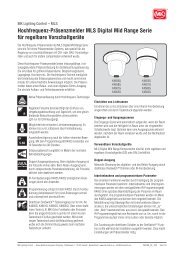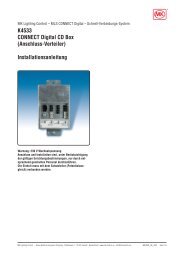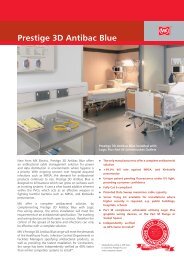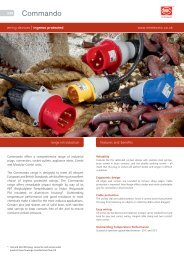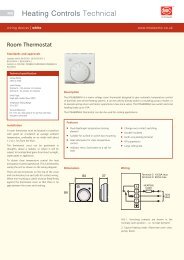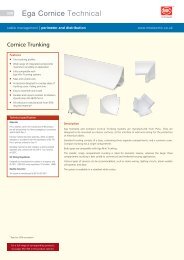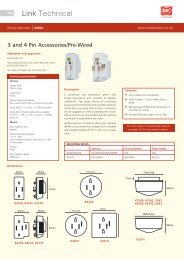Cable Trays - MK Electric
Cable Trays - MK Electric
Cable Trays - MK Electric
Create successful ePaper yourself
Turn your PDF publications into a flip-book with our unique Google optimized e-Paper software.
6.4 According to resistance to flame propagation<br />
6.4.2 <strong>MK</strong> cable trunking systems are non flame progagating.<br />
6.5 According to electrical continuity characteristic<br />
6.5.1 <strong>MK</strong> cable trunking systems have electrical continuity<br />
characteristic.<br />
6.6 According to electrical insulating characteristic<br />
6.6.1 <strong>MK</strong> cable trunking is without electrical insulating<br />
characteristic.<br />
6.7 According to degrees of protection provided by<br />
enclosure according to EN60529:1991<br />
6.7.1 <strong>MK</strong> cable trunking is IP30.<br />
6.9 According to system access cover retention<br />
6.9.2 <strong>MK</strong> cable trunking access cover can only be opened<br />
with a tool.<br />
6.10 According to electrically protective separation<br />
6.10.1 <strong>MK</strong> cable trunking system without internal protective<br />
partition.<br />
6.101 According to intended installation positions.<br />
6.101.3.1 Surface mounted on wall.<br />
6.101.3.2 Surface mounted on ceiling.<br />
6.103 According to type.<br />
6.103.2 Type 2 cable trunking system - distribution.<br />
7 Marketing and documentation<br />
7.1 Each system component is marked by label. Labels<br />
used fully comply with the rubbing test. Boxed items are<br />
labelled on the packaging.<br />
8 Dimensions<br />
There are no dimensions requirements.<br />
9 Construction<br />
9.1 Sharp edges<br />
Surfaces of system components which are likely to come<br />
into contact with cables during installation are inspected<br />
to ensure they shall not cause damage to the cables when<br />
installed correctly.<br />
9.4 Mechanical connections<br />
Screwed connections have been designed to withstand<br />
the mechanical stresses occurring during installation and<br />
normal use and will not cause damage to cables when<br />
correctly inserted. Screwed connections are generally<br />
isometric threads fully compliant with test in accordance<br />
with 9.4.1 of the standard. Screws intended to be tight-<br />
<strong>Cable</strong> Trunking Technical<br />
<strong>Cable</strong> Trunking<br />
ened by means of a screwdriver should be to a torque of<br />
2Nm per Table 4 - Torque values for the test of screwed<br />
connections.<br />
Mechanical connections intended for re-use other than<br />
screwed connections have been tested in accordance with<br />
9.4.2 i.e. fitted and removed 10 times. After the test,<br />
there was no damage to impair the further use of the<br />
mechanical connection i.e. turnbuckle connectors.<br />
9.6 Equipotential bonding<br />
9.6.1 <strong>MK</strong> cable trunking systems should not be used for<br />
equipotential bonding.<br />
9.7 Access to live parts<br />
9.7.1 <strong>MK</strong> cable trunking systems are designed that when<br />
they are installed correctly as in normal use, live parts are<br />
not accessible.<br />
9.7.4 knockouts meet the requirements of EN<br />
61032:1998<br />
9.101 Assembling<br />
<strong>MK</strong> system components fit correctly generally using<br />
integral couplers with plunged and tapped holes.<br />
10 Mechanical properties<br />
<strong>MK</strong> cable trunking systems have been tested to verify the<br />
classifications stated particularly relating to mechanical<br />
strength, impact resistance, system access cover retention<br />
etc.<br />
15 Electromagnetic compatibility<br />
<strong>MK</strong> cable trunking systems are in normal use, passive<br />
in respect of electromagnetic influences (emission and<br />
immunity)<br />
Note: When products covered by this standard are installed<br />
as part of a wiring installation, the installation may emit or<br />
may be influenced by electromagnetic signals. The degree<br />
of influence with depend on the nature of the installation<br />
within its operating environment and the apparatus<br />
connected by the wiring.<br />
121



